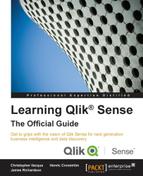It is not only the external market drivers that impact how we use information. Our organizations and the people that work within them are also changing in their attitude towards technology, how they express ideas through data, and how increasingly they make use of data as a competitive weapon.
The consumerization of any technology space is all about how enterprises are affected by, and can take advantage of, new technologies and models that originate and develop in the consumer marker, rather than in the enterprise IT sector. The reality is that individuals react quicker than enterprises to changes in technology. As such, consumerization cannot be stopped, nor is it something to be adopted. It can be embraced. While it's not viable to build a BI strategy around consumerization alone, its impact must be considered.
Consumerization makes itself felt in three areas:
- Technology: Most investment in innovation occurs in the consumer space first, with enterprise vendors incorporating consumer-derived features after the fact. (Think about how vendors added the browser as a UI for business software applications.)
- Economics: Consumer offerings are often less expensive or free (to try) with a low barrier of entry. This drives prices down, including enterprise sectors, and alters selection behavior.
- People: Demographics, which is the flow of Millennial Generation into the workplace, and the blurring of home/work boundaries and roles, which may be seen from a traditional IT perspective as rogue users, with demands to BYOPC or device.
In line with consumerization, BI users want to be able to pick up and just use the technology to create and share engaging solutions; they don't want to read the manual. This places a high degree of importance on the Human-Computer Interaction (HCI) aspects of a BI product (refer to the preceding list) and governed access to information and deployment design. Add mobility to this and you get a brand new sourcing and adoption dynamic in BI, one that Qlik engendered, and Qlik Sense is designed to take advantage of. Think about how Qlik Sense Desktop was made available as a freemium offer.
As times change, so do differentiators. For example, car manufacturers in the 1980s differentiated themselves based on reliability, making sure their cars started every single time. Today, we expect that our cars will start; reliability is now a commodity. The same is true for ERP systems. Originally, companies implemented ERPs to improve reliability, but in today's post-ERP world, companies are shifting to differentiating their businesses based on information. This means our focus changes from apps to analytics. And analytics apps, like those delivered by Qlik Sense, help companies access the data they need to set themselves apart from the competition.
However, to get maximum return from information, the analysis must be delivered fast enough, and in sync with the operational tempo people need. Things are speeding up all the time. For example, take the fashion industry. Large mainstream fashion retailers used to work two seasons per year. Those that stuck to that were destroyed by fast fashion retailers. The same is true for old style, system-of-record BI tools; they just can't cope with today's demands for speed and agility.
A new, tech-savvy generation is entering the workforce, and their expectations are different than those of past generations. The Beloit College Mindset List for the entering class of 2017 gives the perspective of students entering college this year, how they see the world, and the reality they've known all their lives. For this year's freshman class, Java has never been just a cup of coffee and a tablet is no longer something you take in the morning. This new generation of workers grew up with the Internet and is less likely to be passive with data. They bring their own devices everywhere they go, and expect it to be easy to mash-up data, communicate, and collaborate with their peers.
We've all read about how the role of IT is changing, and the question CIOs today must ask themselves is: "How do we drive innovation?". IT must transform from being gatekeepers (doers) to storekeepers (enablers), providing business users with self-service tools they need to be successful. However, to achieve this transformation, they need to stock helpful tools and provide consumable information products or apps. Qlik Sense is a key part of the armory that IT needs to provide to be successful in this transformation.
